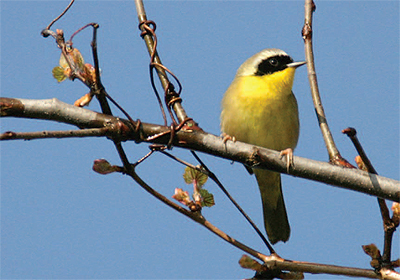Scientists Collect Information on Plant and Animal Species
Hundreds of species of rare and at-risk animals and plants — from wild hyacinth to peregrine falcons — inhabit Pennsylvania.
The Western Pennsylvania Conservancy’s scientists, through the Pennsylvania Natural Heritage Program (PNHP), have documented what and where these species are for the last three decades. This information is stored in the Pennsylvania Natural Diversity Inventory (PNDI), a database of the state’s rich ecology, with a particular emphasis on vulnerable species.
It is a project of PNHP, managed by the Conservancy in partnership with state agencies that manage natural resources. In this endeavor, PNHP has joined a network coordinated by the conservation group NatureServe, in which all 50 states, as well as Canada and Latin America, use common methodologies to collect, analyze and post data. Some of the rare animal and plant information is available online at the PNHP website.

Common yellowthroat.
“You can look up any species of animal or plant and see its geographic range and status anywhere in the Western Hemisphere,” said Jeffrey Wagner, WPC’s PNHP director. “The data provides both a state and a global perspective on elements of biodiversity, both specifically and in their array.”
In addition to helping state agencies manage wildlife and make decisions about land use and development, the data ensures that groups such as WPC invest their conservation dollars in places with the highest natural resource value, according Charles Bier, WPC’s senior conservation scientist. “With limited funding and so many needs, it’s important we go where we can do the most good,” Bier said.
The information on PNHP’s website is also an effective tool for helping the public better appreciate where they live and play. “Is it important to know that mussels are in the Clarion River?” asked Wagner. “If you’re planning to fish or swim there, knowing that there are freshwater mussels in the stream tells you something positive about water quality in the place where you’ll be recreating.”

PNHP assisted PGC staff with peregrine falcon banding at a nest site. Here, WPC herpetologist Charlie Eichelberger climbs a rock face to investigate one of the state’s only cliff nests.
Photo by: Cal Butchkoski, PA Game Commission
Currently, there are over 20,000 records in the PNHP database, reflecting 30 years of research and field work. Partners such as the Pennsylvania Department of Conservation and Natural Resources, Pennsylvania Fish and Boat Commission (PFBC), and Pennsylvania Game Commission (PGC) contribute data from their field work. PGC, for instance, directed the recently completed second Pennsylvania Breeding Bird atlas, for which experts roamed the state documenting avian species, while PFBC is wrapping up surveys of timber rattlesnakes that include tracking and population density studies.
Because the natural world is constantly in flux, the PNDI is evolving, too. “Some populations grow; others fail,” said Wagner. “The loss of bats to white nose syndrome is an example of how rapidly things can change. When people ask, ‘When will you be done with your work?’ the answer, of course, is ‘never.’”
In fact, efforts have become more robust. Just over the last two years, 40 permanent monitoring sites have been established around the state, ranging from limestone habitats to high elevation wetlands, which enable scientists to assess changes over time.
“The County Natural Heritage Inventory Program has been collecting information on the biology of the state, county-by-county since 1989,” said Rocky Gleason, WPC’s county inventory manager located in the Middletown, Pa. office. “The primary focus of these surveys has been on the location and habitat status of plants, animals and natural communities considered rare, threatened or endangered at the global or state level. This information has been provided to county, municipal and regional planning entities and conservation organizations as a means of proactive conservation planning.”
Conversely, an abundance of mussels once documented in the Allegheny and Ohio rivers near Pittsburgh is missing today as a consequence of industrial pollution, dredging and other impacts. Surveying historical sites has spurred recent efforts to encourage the mussels’ return, Bier said. “We’ve gone from 50 species to zero to a dozen in the Ohio River, an indication their habitat is improving,” Bier concluded.
Scientists use such field data to make recommendations about species’ conservation status. Rankings can change as new data is discovered.
“The northeastern bulrush, for instance, is listed as both federally and state-endangered, but over the last 10 or 15 years, we’ve found this vernal pool species in many more locations, so it will probably be reevaluated for listing,” Bier said.
Although the PNHP focuses on rare species and natural communities, there are plans to add exotic and invasive species to the database, because of their potential to compete with natives for habitat and food.
Visit the Pennsylvania Natural Heritage Program’s website at naturalheritage.state.pa.us
